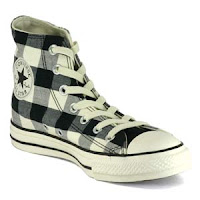Before you criticize someone, you should walk a mile in their shoes. That way when you criticize them, you are a mile away from them and you have their shoes.
- Jack Handey
This NPC gallery is devoted to, more than anything, those NPC features and ideas that most of us don't think about. I don't discuss eyes or hairstyles not because they're not worth talking about, but because people already think about them (these features are often the first thing someone comes up with). But when's the last time you noticed someone's shoes? Ever played a D&D game where the DM noted what the barmaid wore on her feet? Few people look down, few people notice, and that's a shame, as shoes tell us alot about a person. They can tell you how much money he makes, what he believes in, what he cares about, where he's been.
Really, I could stop here. Already, you're thinking about shoes, and that's all this article seeks to accomplish. Still, an NPC gallery article should be longer than a single paragraph, and so I'd like to discuss some shoe specifics. I won't touch on all shoes (there's far too many out there), and I'll focus entirely on modern shoes, leaving it up to the reader to ponder medieval or sci-fi shoes (and already, I can imagine one of my players pondering what G-Verse shoes look like. You know who you are).
Sneakers
The ubiquitous sneaker, the iconic shoe of the modern American. While common, the modern sneaker is far from low-profile. As they're highly commercialized, they tend to have garish designs, often sporting more logos than a NASCAR. Sneakers aren't just eye-catching, but ear-catching, for when their complex design fails, they often squeak. One can hardly imagine an inner-city gangster without sporting some of the more absurd sneaker designs. More conventional sneakers speak of athleticism... of faux-athleticism. A man with bright white pants, sparklingly clean white sneakers and a too-broad smile probably only wears sneakers to give the impression of fitness, while some exhausted youth with well-worn, well-loved sneakers threatening to fall apart probably lives up to the promise of his excellent running shoes.
Canvas Sneakers
Before the advent of the crazy, modern sneaker, we had these. As a child, we often called these "basketball shoes." Nowadays, they seem more strongly associated with the indie music movement and skater punks. They provide an interesting contrast with sneakers: A player might wonder why you're bothering to point out that someone is wearing sneakers, but canvas shoes stand out, worthy of note.
Loafers
To Americans, leather shoes speak of formality. No business suit would be complete without a pair of well-shined loafers. In contrast to squeaky sneakers, loafers make manly clicks whenever they take a step. In Europe, I've found loafers to be far more common. An American would not think to wear a pair of leather shoes with a pair of jeans, but Europeans do so commonly. Such considerations might drive home to a player that he's in a different culture.
Heels
If the world were to name their favorite pair of shoes, heels would probably top the list. These beautiful shoes look elegant on a woman's feet and shape her legs, thus forever associating them with profound sex appeal. High heels also lift a woman up, bringing her eye to eye with taller men, and thus speaks of power. Some women wear shoes that combine both, creating an imperiously enticing appearance. However, high heels require practice to walk in and can hurt the feet if worn for too long; women who wear high heels sacrifice for their fashion. Why would your NPC do that? Something to consider. And always remember the iconic "click" of a woman's heels as she walks.
Flats
Not everyone can or wants to wear heels, and flats represent a perfectly respectable alternative. Because flats lack the complexity, challenge and the appeal of heels, they tend to suggest a humility, a simplicity, or a shyness. A woman who wears flats is either practical, or doesn't believe she can pull off heels, or doesn't want to be seen as a sex symbol, but she's still a woman who believes in looking good, or in formality (after all, she could be wearing sneakers with that skirt, if she was truly casual).
Flip-Flops
Most shoes require at least some effort to wear. Flip flops are slippers one can wear outside. They protect the soles of the feet just enough to count as shoes, but they offer little in the way of comfort or fashion. Thus, flip-flops (as opposed to sandals) tend to suggest a certain laziness or a desire to keep cool (like sandals). Alternately, flip-flops and sandals can offer a somewhat practical way to show off bare feet, if your NPC is the kind that likes to wiggle her toes in public.
Boots
Boots vary wildly. Heavy footwear like boots often suggest an enormous practicality. A man wearing a pair of work boots wears them not because they look good or because they are comfortable, but because they protect his feet from injury or from exhaustion after long kikes. Because the heaviness of boots shape the feet and lower leg, they can also support some heavy-duty fashion. Heeled boots can have all the same appeal as high heels with none of their delicacy or girlishness, giving them a certain ferocity.
Shoes?
Some characters won't bother with shoes at all. Shoes separate the wearer from the ground and they cage the feet. While bare feet aren't very practical (stones can wound the soles), those who don't wear shoes embrace that very impracticality. They tend to be free souls who want to feel the wet grass between their toes. On the other hand, poverty-stricken characters, or particularly poor characters (often both) won't wear shoes because they can't afford them or don't need them. A bare-foot swordsman, for example, probably isn't a free spirit.
Shoes!
As I said before, there are many kinds of shoes: Slippers, moccasins, cowboy boots, combat boots, mules, walking shoes, fashion faux-pas, and stranger. If you poke around, doubtlessly you can find something for your NPC. Not every NPC needs highly detailed shoes, of course, but what a man wears says alot about him. Consider mis-matching expectations: A businessman with an Italian suit and barefeet, or a girl with a mini-skirt and sneakers. Consider, too, that shoes impact several senses at once: Old shoes can smell musty, while new shoes can have a wonderful, leathery scent. Heels tend to click, while sneakers tend to squeak. A good pair of shoes feels wonderful on the feet, while a bad pair of shoes pinch and leave blisters.
So the next time you're pondering an NPC, ponder what they wear on their feet. Let those shoes tell a story for them, and let those shoes announce their presence with the sound of their steps. I think you'll find they add alot of character.











